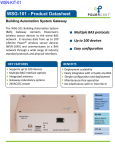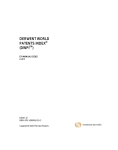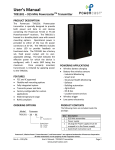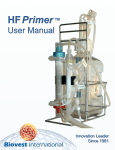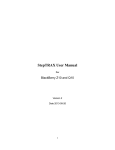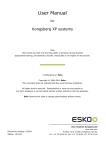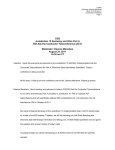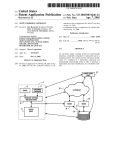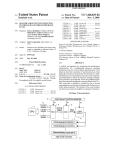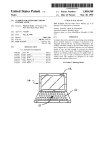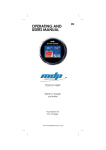Download Self-indicating test page for use in setting density level and color
Transcript
US006034711A Ulllted States Patent [19] [11] Patent Number: Trask et al. [45] [54] SELF-INDICATING TEST PAGE FOR USE IN SETTING DENSITY LEVEL AND COLOR BALANCE IN A COLOR LASER PRINTER Date of Patent: 3-69272 4-170268 _ 3/1991 6/1992 6,034,711 Mar. 7, 2000 Japan ............................. .. H04N 1/46 Japan ............................. .. H04N 1/40 _ Primary Exammer—N. Le Assistant Exammer—Hai C- Pham [75] Inventors: Jeffrey L. Trask; Brian Ho?'mann, [73] Assignee? bOth Hewlett'packard Of Boise, Company, P2110 Alto, Calif A test page, system, and method are used to set a color density level of a laser printer, by producing a dot gain test pattern. The laser printer has at least one primary color. The [21] Appl. No.: 08/611,892 dot gain test pattern is self-indicating and thus requires no _ external reference in order to determine a correct color [22] Flled: Mar‘ 6’ 1996 density level. A preferred embodiment of the dot gain test [51] [52] Int. c1.7 ................................................... .. G03G 15/01 US. Cl. ........................ .. 347/240; 347/251; 347/254; Pattern includes (a) a Stable Pattern having a Color density which is Stable With respect ‘0 Changes in the laser Printer [58] 399/39; 399/49; 399/72 Field of Search ................................... .. 347/240 254 347/251_ 399/39 49 72’ 181’ operating conditions, and (b) a sensitive pattern having a colorflensity Whi‘Fh is sensiFiYe to Chang‘? in the Operating conditions, wherein the sensitive pattern in reference to the ’ [56] ’ ’ ’ stable pattern indicates the density level of the laser printer References Cited for the at least one primary color. Additionally, in a preferred embodiment, the stable pattern includes a uniform coarse 4 310 248 576047567 ’ U.S. PATENT DOCUMENTS 1/1982 Meredith 2/1997 Dundas 356/402 .... .. 399/39 ’ printer for the at least one primary color is indicated When FOREIGN PATENT DOCUMENTS 0518525 a mid-spectrum area of the ?ne dot gradient appears to blend 12/1992 European Pat. on. ....... .. H04N 1/46 0658962 12/1995 62-251628 11/1987 European Pat. Off. H04N 1/60 Japan .............................. .. G01] 3/52 mm the Coarse dot pattern‘ 11 Claims, 4 Drawing Sheets /10 25 15 dot pattern, and the sensitive pattern includes a gradient of ?ne dot densities, the gradient printed adjacent to the coarse dot Pattern’ wherein a Correct density level of the laser 20 U.S. Patent Mar. 7,2000 Sheet 1 of4 an m 6,034,711 U.S. Patent Mar. 7, 2000 Sheet 2 0f 4 6,034,711 0.50 0.45 0.40 ODPETNISCALY 0.35 0.30 0.25 0.20 0.15 0.10 -2 -I 0 +1 DENSITY SETTING +2 + 26dpi +150|pi+ 300|pi SENSITIVITY vs. DOTS/LINES PER INCH FIG. 2 U.S. Patent Mar. 7,2000 I START Sheet 3 of4 I 110 I I // PRINT DDT GAIN TEST PATTERN DDES PATTERN INDICATE A NEED FOR ADJUSTMENT DF CDLDR DENi’SlTY YES ADJUST CDLOR DENSITY LEVEL AS INDICATED BY TEST PATTERN FIG. 3 6,034,711 U.S. Patent Mar. 7, 2000 Sheet 4 of4 6,034,711 220 %%@ FIG. 4 “V Y+ E5 M+ 210 / / M+ , 6,034,711 1 2 SELF-INDICATING TEST PAGE FOR USE IN SETTING DENSITY LEVEL AND COLOR BALANCE IN A COLOR LASER PRINTER Which is sensitive to changes in the operating conditions, Wherein the sensitive pattern in reference to the stable pattern indicates the density level of the laser printer for the at least one primary color. FIELD OF THE INVENTION According to further principles of the present invention in a preferred embodiment, the stable pattern includes a uni form coarse dot pattern, and the sensitive pattern includes a This invention relates in general to image transfer tech nology and, more speci?cally, to a self-indicating test page for use in setting color density level in a laser printer. BACKGROUND OF THE INVENTION In laser printers, both the engine electro-photographic (EP) process control tables and the formatter pulse-Width (PW) control tables are based on print quality characteriZa tion done during life testing. HoWever, factors such as the usage rate, EP process components, and printing environ gradient of ?ne dot densities, the gradient printed adjacent to 10 Other objects, advantages, and capabilities of the present invention Will become more apparent as the description 15 FIG. 1 is a dot gain test pattern produced by a laser printer using a preferred embodiment of the present invention. FIG. 2 is a graph shoWing the dot sensitivity to changes in developer AC bias voltage and/or laser poWer versus dots These color differences are a signi?cant cause of service per inch or lines per inch. FIG. 3 is a How chart shoWing a preferred method of the 25 present invention. FIG. 4 is a preferred embodiment of a gray balance test detectors inside the printer. The optical density detectors provide feedback to the printer Which, in turn, adjusts the color density levels. This approach adds cost and complexity pattern. DETAILED DESCRIPTION OF THE INVENTION to the printer. Another approach is to print out a test page and to compare the test page With a reference page, typically included in the user’s manual. This approach is inconvenient, because it requires the user to keep track of the FIG. 1 is a preferred embodiment of a dot gain test pattern 10 produced by a laser printer according to principles of the present invention for testing the optical density of a color of reference page, and dif?cult, because it requires from the user the ability to accurately compare the test page With the reference page. In order to maintain consistent color densities in offset proceeds. DESCRIPTION OF THE DRAWINGS ment Will vary over time. It is not possible to anticipate hoW these factors Will vary from life test conditions. Changes in these factors cause noticeable and typically objectionable color density differences betWeen printers over time. calls on color laser printers, Which usually result in replace ment of the drum cartridge and/or replacement of the color developer. Prior methods of correcting the color differences Without a service call include installing optical density the coarse dot pattern, Wherein a correct density level of the laser printer for the at least one primary color is indicated When a mid-spectrum area of the ?ne dot gradient appears to blend into the coarse dot pattern. 35 printing, a dot gain test is used. In the color printing industry, offset printing is the standard for producing high quality, the laser printer. The test pattern 10 is typically printed on a test page by the laser printer. The dot gain test pattern 10 comprises a portion that is a uniform coarse dot pattern 15 and a portion that is a ?ne dot gradient 20. In this embodiment, arroWs 20, disposed across the page, represent the ?ne dot gradient 20. Obviously, hoWever, other patterns color results. A dot gain test compares the appearance of ?ne dots With the appearance of much coarser dots. The high perimeter/area ratio of the ?ne dots makes them much more could equally be used. The coarse dot pattern 15 is uniform in optical density. In a preferred embodiment the coarse dot pattern 15 is 26 dots per inch (dpi). The ?ne dot gradient 20 sensitive to factors that cause more or less ink to be varies in optical density, producing a spectrum ranging from high to loW optical density. In the ?gure, high to loW density deposited. A gradient of ?ne dot densities is printed in a uniform coarse dot background. When vieWed from a dis is portrayed from left to right, varying from arroW 20 to tance Where the coarse dots cannot be independently 45 arroW 20 across the page, each arroW 20 having a uniform distinguished, the mid-spectrum area of the ?ne dot gradient blends into the coarse dot background, if the color density is density. The optical density of the ?ne dot gradient 20 is varied by pulse-Width modulation of the laser beam to produce the spectrum of optical densities. In a preferred embodiment, the ?ne dot gradient 20 is 150 lines per inch correct. Accordingly, given the forgoing backgrounds relating to offset printing, color laser printers, and color density levels, (Lpi). In a laser printer With a correct density level, at some objects of the present invention are to provide a neW test point along the ?ne dot gradient 20 (across the page), the page, system, and method for setting the color density level of a laser printer. SUMMARY OF THE INVENTION 55 point Where the optical densities essentially match, the ?ne According to principles of the present invention in a dot gradient 20 Will appear to blend in With the coarse dot preferred embodiment, a test page, system, and method are used to set a color density level of a laser printer, by background 15. providing a dot gain test pattern. The laser printer has at least one primary color. The dot gain test pattern is self-indicating Although the test pattern 10 is shoWn using only the color black, the test pattern 10 Will Work equally Well for any of the primary colors of a laser printer. For a typical laser printer, the only primary color is black For a color laser printer the additional primary colors are typically cyan, and thus requires no eXternal reference in order to determine a correct color density level. A preferred embodiment of the dot gain test pattern includes (a) a stable pattern having a color density Which is stable With respect to changes in the laser printer operating conditions, and (b) a sensitive pattern having a color density optical density of the ?ne dots Will essentially match the optical density of the uniform coarse dot background 15. A laser printer With a correct density level Will produce pat terns With an optical density of essentially 0.27:0.05. At the 65 magenta, and yelloW (CMY). In a preferred embodiment for a correct color density, the point at Which the ?ne dot gradient 20 blends into the coarse 6,034,711 3 4 dot pattern 15 is located in the area 25 mid-spectrum across the gradient 20. A correct color density indicates that no printers are not self-indicating because they rely on a comparison betWeen the test pattern and some external reference. Typically the external reference is included in the user’s manual. The external reference could also be the change in color density is needed. If the point at Which the ?ne dot gradient 20 blends into the coarse dot pattern 15 is not located in the area 25 mid-spectrum across the gradient 20, then a need for a change in color density is indicated. In memory of the user. If a user has to look at a test pattern and use judgement to determine if the color density appears correct, the user’s memory of What a correct color density this embodiment, if the point at Which the ?ne dot gradient 20 blends into the coarse dot pattern 15 is located to the left of the mid-spectrum area 25, then a need for an increase in color density is indicated. Conversely, if the point at Which the ?ne dot gradient 20 blends into the coarse dot pattern 15 is located to the right of the mid-spectrum area 25, then a need for a decrease in color density is indicated. The ?ne dots Which make up the ?ne dot gradient 20 are actually fractions of a full dot. As such, the ?ne dots do not looks like is an external reference. 10 for the laser printer has the ability to modify the developer AC bias voltage and the laser poWer. In a preferred 15 receive full exposure to the drum. The ?ne dots are very sensitive to changes in the operating conditions of the printer because of their less than full exposure to the drum. In contrast, the coarse dots are actually clusters of full dots. Each full dot receives full exposure to the drum. 20 Accordingly, the coarse dots are not very sensitive to changes in the operating conditions of the printer. Changes in the operating conditions Which may affect the color density produced by the laser printer include, but are not limited to, humidity, temperature, the discharge voltage of 25 the photoconductor, laser poWer, developer AC bias, toner charge, and frequency of use. Differences in sensitivity to the operating conditions can be demonstrated by shoWing hoW the different dot siZes react to a change in laser poWer and/or developer AC bias voltage. 30 35 FIG. 3 is a How chart shoWing a preferred method of the present invention. Referring to FIGS. 1 and 3, the ?rst step pattern 10 indicates Whether the color density needs to be adjusted and Whether the color density needs to be increased or decreased. If the color density does need to be adjusted, the user adjusts the color density 120 as indicated for the primary color in Which the test pattern 10 Was printed. Another dot gain test pattern 10 is then printed 110 in the bias increases. 40 over the range from 26 dpi to 300 Lpi, the effect of a change same color as the ?rst dot gain test pattern 10. If the test pattern 10 indicates that another adjustment in color density is necessary, the process is repeated until the color density for the tested color is correct. in density setting on the optical density, also increases. At 26 dpi, the optical density varies from approximately 0.24 to Lpi, the optical density varies from approximately 0.13 to 0.50 for the same change in density setting. developer AC bias voltage and the laser poWer. The density setting is adjusted in reference to the dot gain test pattern 10 is to print 110 a dot gain test pattern 10 in a primary color. Next, the test pattern 10 is examined by a user 115. The test the relationship betWeen the dpi (or Lpi) and the change in 0.29 for a change in density setting from —2 to +2. At 300 bias increases. The area along the ?ne dot gradient 20 that blends in With the coarse dot pattern 15 Will be shifted by a change in the developer AC bias voltage or the laser poWer. This shift is due to the difference in hoW the ?ne dot gradient 20 and the coarse dot pattern 15 are affected by the change in the high. FIG. 2 graphically shoWs the difference in sensitivity The graph clearly shoWs that as the dpi (or Lpi) increases embodiment, adjustments in the laser poWer and/or devel oper AC bias voltage from the normal electro-photographic (EP) process tables are represented by a change in a density setting. As discussed above, typically, as the setting increases, the laser poWer increases and the developer AC Which indicates Whether the color density is too loW or too betWeen the ?ne dots and the coarse dots. The graph shoWs optical density caused by a change in laser poWer and/or developer AC bias voltage. These changes in laser poWer and/or developer AC bias voltage are represented by changes in a density setting. In general, as the setting increases, the laser poWer increases and the developer AC In order to remedy an incorrect color density, compensa tion is made to account for the change in operating condi tions from life test conditions. The process control engine Although reference has been made only to one dot gain 45 test pattern 10 on the test page, it is noted that multiple dot gain patterns 10, each for a different primary color may be printed on each test page. Since the ?ne dots are much more sensitive to the oper In addition to a dot gain test, a gray balance test may be ating conditions than the coarse dots, the optical density of printed on the test page. A gray balance test is also referred the ?ne dots is affected much more than the optical density 50 to as a neutral gray test. A gray balance test is employed in of the coarse dots by a change in the operating conditions. Therefore, a change in operating conditions results in a shift of the area along the ?ne dot gradient 20 Where the ?ne dots order to balance the color densities of the primary colors, typically CMY. The gray balance test is also a more visible appear to blend into the coarse dot background. The coarse dot pattern 15 acts as a stable reference compared to the ?ne 55 dot gradient 20, thus the test page is self indicating and no external reference is needed. Since the ?ne dot gradient 20 is affected more than the colors, a light neutral gray area is produced using only the primary colors CMY. Another light neutral gray area is produced using only the color black. The tWo areas of light neutral gray are compared. If the balance of CMY colors is coarse dot pattern 15 by changes in operating conditions, the coarse dot pattern 15 has a stable optical density, relative to 60 the optical density of the ?ne dot gradient 20, for all acceptable operating conditions. Acceptable operating con ditions are those operating conditions Which alloW the laser printer to function properly as a laser printer. The dot gain test pattern 10 is self-indicating because no external reference is needed in order to determine if the color density is correct. Other types of test patterns for laser Way to check for the correct amount of yelloW color density than the dot gain test pattern 10. In order to balance the color densities of the primary not correct, the “neutral gray” produced With only CMY Will have a noticeable hue compared to the same neutral gray produced With only black. In a preferred embodiment, the gray balance test pattern is composed of 25 circles in a grid, as shoWn in FIG. 4. The 65 grid background 215 is a light neutral gray color composed of black only. The circles 205 are also a light neutral gray color, but composed of CMY only. Each circle has a slightly 6,034,711 6 5 different hue representative of a high or loW density of one or tWo of the primary colors. The circles are arranged so that they constitute a tWo directional spectrum ranging from loW magenta, and yelloW. to high density for each of tWo primary colors in each of the tWo directions. In this embodiment, the density of yelloW printer, the laser printer having at least one primary color, varies from loW to high in the direction from the bottom of the pattern to the top and magenta varies from loW to high in the direction from left to right. The center circle 210 of the gray balance test should match the background 215. If the center circle 210 does not 5. The test page of claim 4 Wherein at least one primary color is selected from the group consisting of black, cyan, 6. A system for setting a color density level of a laser the system comprising: (a) means for producing a stable pattern having a color density Which is stable With respect to changes in operating conditions of the laser printer; 10 match the background 215, a change in color density is indicated. If a circle other than the center circle 210 matches the background 215, the test pattern indicates hoW the density levels should be changed in order to obtain a correct color balance. 15 For example, if the upper right circle 220 matches the (b) means for producing a sensitive pattern having a color density Which is sensitive to changes in the operating conditions of the laser printer; and, Wherein the sensitive pattern in reference to the stable pattern indicates, Without reference to any other source, the density level of the laser printer for the at least one primary color. 7. The system of claim 6 Wherein the stable pattern background 215, the magenta and yelloW color density includes a uniform coarse dot pattern, and Wherein the levels are both too loW. Since the matching circle 220 is tWo circles aWay from the center circle 205 in both the horiZontal sensitive pattern includes a gradient of ?ne dot densities, the gradient printed adjacent to the coarse dot pattern, Wherein a correct color density level of the laser printer for the at least one primary color is indicated When a mid-spectrum and vertical directions, both magenta and yelloW should be increased by tWo density levels. area of the ?ne dot gradient appears to blend into the coarse In summary, What has been described above are the dot pattern. preferred embodiments for a system and method for setting the color density level of a laser printer and a test page for use in setting the color density level of a laser printer. While the present invention has been described by reference to speci?c embodiments, it Will be obvious that other alterna tive embodiments and methods of implementation or modi ?cation may be employed Without departing from the true spirit and scope of the invention. What is claimed is: 1. A test page produced by a laser printer, the laser printer having at least one primary color, the test page for setting a density level of the laser printer for the at least one primary color, the test page comprising: (a) a stable pattern having a color density Which is stable With respect to changes in operating conditions of the 25 35 in reference to the stable pattern indicates, Without reference to any other source, the density level of the laser printer for the at least one primary color of the laser printer; and, (c)adjusting the color density level of the laser printer for laser printer; the at least one primary color based on visual obser vation of the sensitive pattern in reference to the stable (b) a sensitive pattern having a color density Which is sensitive to changes in the operating conditions of the pattern. 9. The method of claim 8 Wherein the stable pattern laser printer; and, Wherein the sensitive pattern in reference to the stable pattern indicates, Without reference to any other source, the density level of the laser printer for the at least one primary color. 2. The test page of claim 1 Wherein the stable pattern 8. A method for setting a color density level of a laser printer, the laser printer having at least one primary color, the method comprising: (a) printing a stable pattern having a color density Which is stable With respect to changes in operating conditions of the laser printer; (b) printing a sensitive pattern having a color density Which is sensitive to changes in the operating condi tions of the laser printer, Wherein the sensitive pattern includes a uniform coarse dot pattern, and Wherein the 45 sensitive pattern includes a gradient of ?ne dot densities, the gradient printed adjacent to the coarse dot pattern, Wherein a correct color density level of the laser printer for the at least one primary color is indicated When a mid-spectrum includes a uniform coarse dot pattern, and Wherein the area of the ?ne dot gradient appears to blend into the coarse sensitive pattern includes a gradient of ?ne dot densities, the gradient printed adjacent to the coarse dot pattern, Wherein dot pattern. 10. The method of claim 8 further including repeating steps (a) and (b) until the color density level is correct. 11. The method of claim 8 further including: (a) printing a gray balance test pattern; and, (b) further adjusting the color density level of the laser a correct density level of the laser printer for the at least one primary color is indicated When a mid-spectrum area of the ?ne dot gradient appears to blend into the coarse dot pattern. 3. The test page of claim 1 Wherein at least one primary color is selected from the group consisting of black, cyan, magenta, and yelloW. 4. The test page of claim 1 further including a gray balance test pattern. 55 printer for the at least one primary color based on visual observation of the gray balance test pattern.










